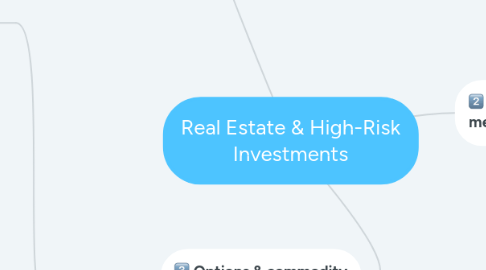
1. Real estate
1.1. Real estate consists of
1.1.1. land
1.1.2. all permanent structures
1.1.3. rights & privileges
1.1.3.1. like crop or mineral rights
1.2. 2 key questions:
1.2.1. Can you make income while you own?
1.2.1.1. Price-to-rent ratio
1.2.1.1.1. ratio of median real estate prices to median rental prices of the real estate
1.2.1.2. cash-flow
1.2.1.2.1. rental income left over after paying operating expenses
1.2.1.3. rental yield
1.2.1.3.1. computes how much income investor might pocket from rent before mortgage payments as a % of purchase price
1.2.1.3.2. most properties yield about 4% annually
1.2.1.3.3. = (rent/2)/purchase price
1.2.2. Can you profit when you sell the property?
1.2.2.1. capital gain
1.2.2.1.1. amount > ownership costs of investment
1.3. Tax advantages - 5 special tax treatments
1.3.1. depreciation
1.3.1.1. is the decline in value of an asset over time from normal use
1.3.1.2. can deduct depreciation from rental income
1.3.2. interest
1.3.2.1. interest expense from mortgage loan is deductible from rental income
1.3.3. capital gains
1.3.3.1. taxed much lower (15%) than wage income
1.3.4. exchange of property
1.3.4.1. property can be exchanged for a similar property tax-free
1.3.5. vacation home rental income
1.3.5.1. tax-free if 14 days or less per year
1.4. Pricing real estate
1.4.1. discounted cash-flow
1.4.1.1. can estimate the present value of investment
1.5. Financing real estate
1.5.1. seller financing
1.5.1.1. property owner accepts a promissory note from buyer
1.5.1.2. buyer then make monthly payments to owner
1.5.2. sweat equity
1.5.2.1. buy a property that needs work but has good underlying value
1.5.2.2. fix it up to rent/sell at a profit
1.6. Robert Kiyosaki video
2. Options & commodity futures contracts
2.1. Derivatives
2.1.1. instrument to trade an asset upon which the instrument is based
2.1.2. 2 most common instruments:
2.1.2.1. Options
2.1.2.1.1. a contract to buy/sell at some point in the future at a strike price
2.1.2.1.2. most common
2.1.2.1.3. 2 types:
2.1.2.1.4. video
2.1.2.2. Futures contracts
2.1.2.2.1. is the obligation to make or take delivery of a certain amount of a commodity by a set date.
2.1.2.2.2. video
3. Collectibles, precious metals, gems
3.1. collectibles
3.1.1. How to find value of
3.2. gold & other metals
3.2.1. gold
3.2.1.1. ways to invest:
3.2.1.1.1. gold bullion
3.2.1.1.2. gold bullion coins
3.2.1.1.3. collectible gold coins
3.2.1.1.4. gold mining stocks, mutual funds, EFTs
3.2.2. other metals
3.2.2.1. silver, platinum, palladium, rhodium
3.2.3. prices
3.3. precious stones & gems
3.3.1. diamonds, sapphires, rubies, emeralds..
3.3.2. value
